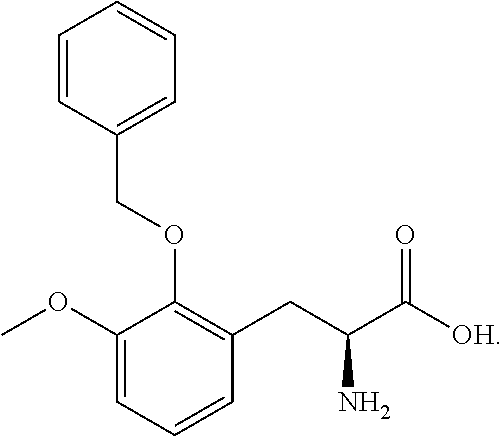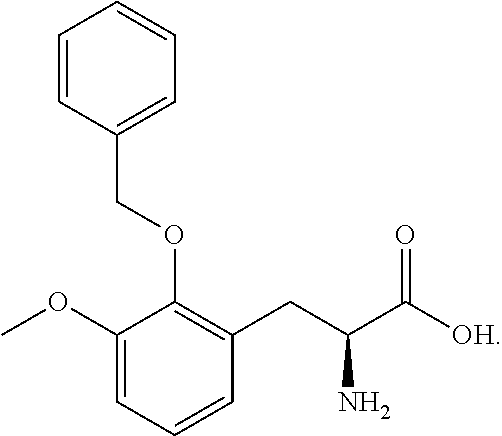Engineered phenylalanine ammonia lyase polypeptides
a technology of phenylalanine ammonia and polypeptides, which is applied in the direction of lyases, carbon-nitrogen lyases, enzymology, etc., can solve the problems of poor stability under industrially useful process conditions, poor or no activity on substrates containing bulky or electron-rich substituents, and undesirable properties, so as to improve stability, improve thermostability, and improve enantioselectivity
- Summary
- Abstract
- Description
- Claims
- Application Information
AI Technical Summary
Benefits of technology
Problems solved by technology
Method used
Image
Examples
example 1
Preparation of HTP PAL Containing Wet Cell Pellets
[0220]A synthetic gene (SEQ ID NO: 1) encoding Anabaena variabilis phenylalanine ammonia lyase (AvPAL) (SEQ ID NO: 2) optimized for expression in E. coli was cloned into a pCK110900 vector. An evolved variant of wild-type AvPAL (SEQ ID NO: 2) that was more stable and had tyrosine ammonia lyase activity was chosen as the parent gene (SEQ ID NO: 4). W3110 E. coli cells were transformed with the respective plasmid containing the parent PAL encoding gene (SEQ ID NO: 3) and plated on LB agar plates containing 1% glucose and 30 μg / ml chloramphenicol (CAM), and grown overnight at 37° C. Monoclonal colonies were picked and inoculated into 180 μl LB containing 1% glucose and 30 μg / mL chloramphenicol and placed in the wells of 96-well shallow-well microtiter plates. The plates were sealed with O2-permeable seals and cultures were grown overnight at 30° C., 200 rpm and 85% humidity. Then, l of each of the cell cultures were transferred into the...
example 2
Preparation of HTP PAL-Containing Cell Lysates
[0221]Frozen pellets prepared as described in EXAMPLE 1 were lysed with 400 μl lysis buffer containing 100 mM triethanolamine buffer, pH 7.5, 1 g / L lysozyme and 0.5 g / L. The lysis mixture was shaken at room temperature for 2 hours. The plate was then centrifuged for 15 min at 4000 rpm and 4° C. The supernatants were then used in biocatalytic reactions as clarified lysate to determine enzymatic activity.
example 3
Preparation of Lyophilized Lysates from Shake Flask (SF) Cultures
[0222]A single colony containing the desired gene picked from an LB agar plates with 1% glucose and 30 μg / ml CAM, and incubated overnight at 37° C. was transferred to 6 ml of LB with 1% glucose and 30 μg / ml CAM. The culture was grown for 18 h at 30° C., 250 rpm, and subcultured approximately 1:50 into 250 ml of TB containing 30 μg / ml CAM, to a final OD600 of about 0.05. The subculture was grown for approximately 195 minutes at 30° C., 250 rpm, to an OD600 between 0.6-0.8, and induced with 1 mM IPTG. The subculture was then grown for 20 h at 30° C. and 250 rpm. The subculture was centrifuged at 4000 rpm for 20 min. The supernatant was discarded, and the pellet was resuspended in 35 ml of 25 mM triethanolamine buffer, pH 7.5. The cells were lysed using a Microfluidizer® processor system (Microfluidics) at 18,000 psi. The lysate was pelleted (10,000 rpm×60 min), and the supernatant was frozen and lyophilized to generate s...
PUM
| Property | Measurement | Unit |
|---|---|---|
| mass | aaaaa | aaaaa |
| pKa | aaaaa | aaaaa |
| temperature Tm | aaaaa | aaaaa |
Abstract
Description
Claims
Application Information
 Login to View More
Login to View More - R&D Engineer
- R&D Manager
- IP Professional
- Industry Leading Data Capabilities
- Powerful AI technology
- Patent DNA Extraction
Browse by: Latest US Patents, China's latest patents, Technical Efficacy Thesaurus, Application Domain, Technology Topic, Popular Technical Reports.
© 2024 PatSnap. All rights reserved.Legal|Privacy policy|Modern Slavery Act Transparency Statement|Sitemap|About US| Contact US: help@patsnap.com










